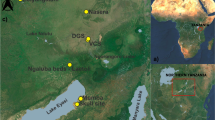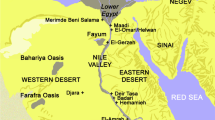Abstract
Because mining has gone on in the United Kingdom for centuries there is a legacy of the shafts left behind, most of which are unrecorded. Where land is to be developed and the presence of an old shaft is suspected, the location of the shaft must be determined so that shaft can be dealt with. The primary reason for this is that an abandoned shaft may pose a potential danger. Frequently when shafts were abandoned they were inadequately filled or simply sealed over at the surface. Hence the possibility of shaft collapse exists or the land around a shaft may subside. If superficial deposits surround the shaft, collapse leads to the formation of a crater at the surface, the diameter of which is much larger than that of the shaft.
The location of an old shaft involves a number of stages, of which the desk study is important. This may involve the use of aerial photographs in areas which have not been built over. The use of some geophysical and geochemical techniques have on occasions proved of value in such an operation. Nonetheless the exact location of a shaft can only be proved by its exposure by direct methods of exploration, that is, by excavation or drilling.
Résumé
Les exploitations minières ont été nombreuses en Grande Bretagne à travers les siècles et la plupart des puits abandonnés ne sont pas repérés. Lorsqu'un aménagement est projeté et que la présence d'un ancien puits est suspecté, il est nécessaire de le repérer afin d'en tenir compte, en raison des dangers qu'il peut présenter. Ces puits abandonnés ont en effet souvent été insuffisamment remblayés, parfois même simplement obturés en surface, avec des possibilités d'effondrement ou d'affaissement pour les terrains voisins. Si des dépôts superficiels entourent le puits, l'effondrement peut provoquer un cratère en surface, dont le diamètre est de beaucoup supérieur à celui du puits.
Le repérage d'un ancien puits se fait en plusieurs étapes, parmi lesquelles l'étude prélable s'avère très importante. Elle peut comprendre l'utilisation des photographies aériennes dans les zones non construites; les techniques geophysiques et geochimiques se sont également révélées utiles. Finalement la localisation précise d'un puits ne peut être certaine qu'en utilisant des méthodes directes d'exploration, c'est-à-dire la fouille ou le sondage.
Similar content being viewed by others
References
ANON, 1976: Reclamation of Derelict Land: Procedure for Locating Abandoned Mine Shafts. Department of the Environment, London.
ANON, 1981a. Code of Practice for Site Investigations, BS5930. British Standards Institution, London.
ANON, 1981b: Code of Safe Drilling Practice. Part I, Surface Drilling. British Drilling Association, London.
ANON, 1982: Treatment of Disused Mine Shafts and Adits. National Coal Board, London.
BALLARD R. F., CUENOD, Y. and JENNI J.P., 1983: Detection of Karst Cavities by Geophysical Methods. Bulletin of the International Association of Engineering Geology, No. 26–27, pp. 153–157.
BURTON A.N. and MATON P.I., 1975: Geophysical Methods in Site Investigation in Areas of Mining Subsidence in Site Investigations in Areas of Mining Subsidence (Ed by F.G. Bell), Newnes-Butterworths, London, pp. 75–102.
DEAN J.W., 1967: Old Mine Shafts and Their Hazard. Mining Engineer, Vol. 126, pp. 368–377.
DEARMAN W.R., BAYNES F.J. and PEARSON, R., 1977: Geophysical Detection of Disused Mine Shafts in the Newcastle-upon-Tyne Area, North East England. Quarterly Journal of Engineering Geology, Vol. 10, pp. 257–270.
GREGORY O., 1982: Defining the Problems of Disused Coal Mine Shafts. Chartered Land Surveyor/Chartered Mineral Surveyor, Vol. 4, No. 2, pp. 4–15.
HEALY P.R. and HEAD J.M., 1984: Construction over Abandoned Mine Workings. Construction Industry Research and Information Association, Special Publication 32, London.
HIGGINBOTTOM I.E., 1976: The Use of Geophysical Methods in Engineering Geology. Part 2, Electrical Resistivity, Magnetometer and Gravity Methods. Ground Engineering, Vol. 9, No. 2, pp. 34–38.
HOOPER J.W. and McDOWELL P.W., 1977: Magnetic Surveying for Buried Mine Shafts and Wells, Ground Engineering, Vol. 10, No. 2, pp. 21–23.
HOWELL M. and AMOS G.W., 1975: Improved Geophysical Techniques for Survey of Disturbed Ground, in Site Investigations in Areas of Mining Subsidence (Ed. by F.G. Bell), Newnes-Butterworths, London, pp. 103–108.
KOERNER R.M., LORD A.E., BOWDERS J.J. and DOUGHERTY W.W., 1982: CW Microwave Location of Voids beneath Paved Areas. Proceedings of the American Society of Civil Engineers, Journal of the Geotechnical Engineering Division Vol. 108, No. GTI, pp. 133–144.
LEGGO P.J., 1982: Geophysical Applications of Ground Impulse Radar. Transactions of the Institution of Mining and Metallurgy, Section B—Applied Earth Science, Vol. 91, pp. B1-B5.
LEGGO P.J. and LEACH C., 1982: Subsurface Investigation for Shallow Mine Workings and Cavities by the Ground Impulse Radar Technique. Ground Engineering, Vol. 15, No. 1, pp. 20–24.
MAXWELL G.M., 1975: Some Observations on the Limitations of Geophysical Surveying in Locating Anomalies from Buried Cavities associated with Mining in Scotland. Mining Engineer, Vol. 134, pp. 277–285.
MAXWELL G.M., 1976: Old Mine Shafts and Their Location by Geophysical Surveying. Quarterly Journal of Engineering Geology, Vol. 9, pp. 283–290.
McCANN D.M., GRAINGER P. and McCANN C., 1975: Interborehole Acoustic Measurements and Their Use in Engineering Geology. Geophysical Prospecting, Vol. 23, pp. 50–69.
McDOWELL P.W., 1981: Recent Developments in Geophysical Techniques for the Rapid Location of Near-Surface Anomalous Ground Conditions. Ground Engineering, Vol. 14, No. 3, pp. 20–23.
MORSE C.F.R., Nov 1967: Some Mining Problems encountered during the Construction of a Section of the M6 Motorway adjacent to Walsall in Staffordshire. Chartered Surveyor, pp. 236–243.
RAYBOULD D.R. and PRICE D.G., 1966: The Use of the Proton Magnetometer in Engineering Geological Investigation. Proceedings of the 1st International Congress of Rock Mechanics, Lisbon, Vol. 1, pp. 11–14.
RUSSELL O.R., AMATO, R.V. and LESHENDOC T.V., 1979: Remote Sensing and Mine Subsidence in Pennsylvania. Proceedings of the American Society of Civil Engineers, Transportation Engineering Journal, Vol. 105, No. TE2, pp. 185–198.
SYMONS M.V., 1978: Sources of Information for Preliminary Site Investigation in Old Coal Mining Areas. Proceedings of Conference on Large Ground Movements, Cardiff (Ed. by J.D. Geddes), Pentech Press, London, pp. 119–135.
Author information
Authors and Affiliations
Rights and permissions
About this article
Cite this article
Bell, F.G. Land development. State-of-the-art in the location of old mine shafts. Bulletin of the International Association of Engineering Geology 37, 91–98 (1988). https://doi.org/10.1007/BF02590374
Published:
Issue Date:
DOI: https://doi.org/10.1007/BF02590374




